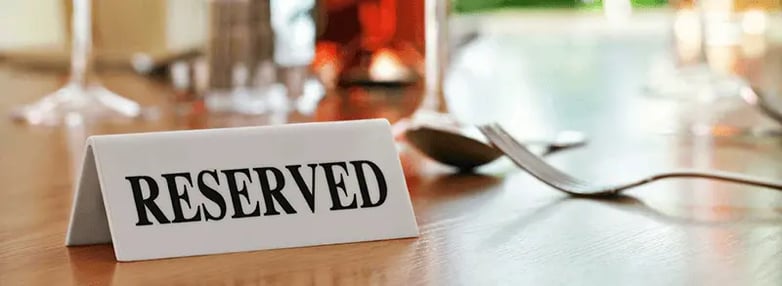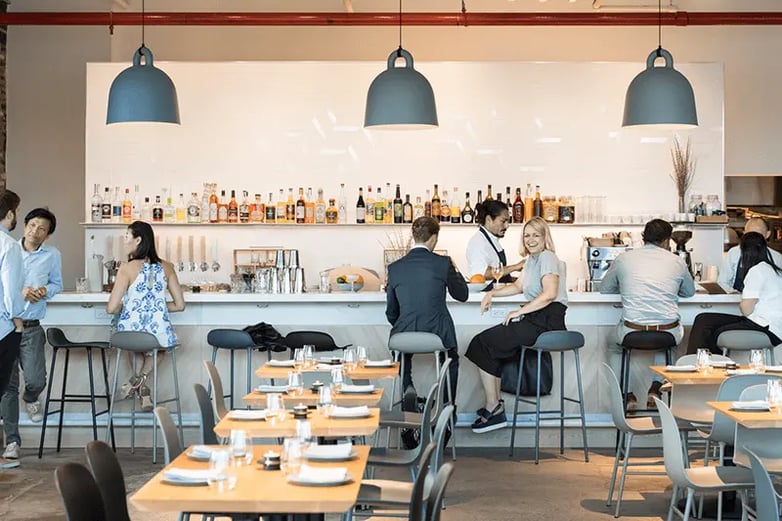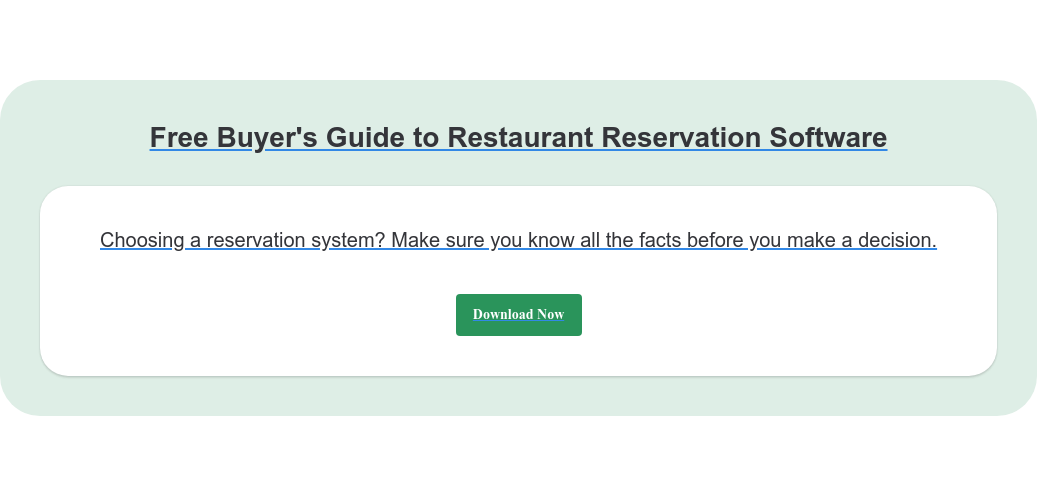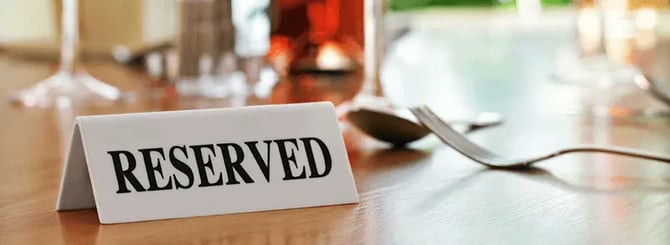At the end of the day, both reservations and walk-ins generate revenue at a restaurant. But for some restaurants leaning heavily toward one may be the catalyst that gets your flow going. In this article, we will identify which client traffic base to lean toward, and most importantly establish a balance between the two.
Getting the mix between reservations and walk-ins right is part of optimal restaurant management.

The benefits of reservations
Everyone likes to know how full the house will be ahead of time. Everyone. With the foresight that reservations give, you can staff accordingly, making possible cuts or additions if the service calls for it.
That large group celebrating a cousin’s birthday? Good thing there is a reservation.
It’s quite wise to first establish what calls for a reservation. Many restaurants make it mandatory for groups of four or more to have a reservation. This way your kitchen and serving staff are well-prepared by the time of arrival. This also allows you to take into account any special dietary restrictions or extravagant pieces to the meal.
A business dinner wants a mini-bar set up in the corner of the restaurant. Surprisingly common, and yes also a great situation for the restaurant. But only when there is a reservation.
Reservations can make the grandiose seem doable and provide projects for your restaurant team to tackle together. This helps promote core values.
That VIP group that wants their section to have a fondue chocolate fountain ready for dessert, along with their custom dessert menu? This is all easily handled ahead of time. More importantly, if a custom menu is desired, this can sometimes be a fun way to collaborate between departments.
Say a couple is having an anniversary dinner. They have been coming into the restaurant for years and always request the same server. Tonight is a big night for them, and they expect a lot. More importantly, your server that always caters to them has a good relationship with them and wants to give them the best.
Once again, the power of reservations comes through. You can have your server communicate with the kitchen on items they are particular about as well as dietary restrictions. That way when they arrive, not only will their anticipations be met, but you have had time to set up for a surprise and delight.
Reservations also allow you to know how many open tables (if any) you have going into a service. This gives a bit of breathing room to your floor staff. As the servers and bussers know how much silverware and linen they will have to prepare, and the host/hostess will have time to organize the floor through their digital reservation system.
The weakness of reservations
Reservations, while usually dependable, are not surefire. A less-than-ideal situation can sometimes occur in restaurants where you find yourself overstaffed for a small crowd. Due to reservation volumes, you may have anticipated much, much more.
Sometimes people can flake. And when this happens there’s virtually no control over it. No-shows continue to be a problem for restaurants. Restaurant automation systems attempt to curb this issue with hyper-personalization.
There is one way to attempt to control dropped reservations, and that is focusing on the quality of each reservation. If over the phone, try to get to know as much about the dining party as possible. Be sure to get names, occasion (if any), dietary restrictions if any, and if they have any other special requests. People are simply more likely to show when they know they are being thought of.
If your reservation system is online, there’s no real interaction and therefore it is harder to get the customer interested. If you can, focus on the reservation portal itself. Make it as easy to use as possible.
There is also the case of overbooking. There can occasionally be a lag in what is reserved through your online portal. This means additional reservations can be made over the phone even though the house is booked.
There is nothing people hate more than being told their reservation is not being honored due to an overbook. The practice of double bookings however is something most restaurants can try to boost revenue and is greatly helped by reservation systems.

The benefits of walk-ins
Walk-ins can either be anticipated or come as a complete surprise. If you know that your busiest day is Friday, then anticipate high volumes for that day. If you can anticipate the low days enough, you can make cuts accordingly.
Many operators prefer walk-ins, especially for lower check sizes because of the flexibility. If you are required to have a table set aside for a certain time you're potentially unable to seat a walk-in during, but also either side of the reservation time. For fine dining restaurants, the guarantee of a customer may be more appealing as margins are higher.
By using analytics you can predict the volume of walk-ins at any given time and open tables to reservations accordingly.
The weakness of walk-ins
Sometimes you can receive a large volume of walk-in reservations while also coping with an enormous amount of reservations. Traffic like this is stressful and places a lot on your serving team. More than likely your team will make a few errors during service too if rushed.
Relying on walk-ins alone is usually not sustainable unless you’re a very well-known establishment. Under normal circumstances, the volume alone will not be enough to sustain any restaurant.
Further reading
Finding the balance
Unless you are a cornerstone in the community and a city-wide name, you need to have a balance of walk-ins and reservations.
Those unbeatable BBQ restaurants that run out of brisket by noon every day? They still have reservations.
Even if you have a steady flow of walk-ins, you still need to be able to cater to larger groups. This is most effectively handled with reservations made online or over the phone.
A savvy restauranteur will recognize the balance of reservations based not only on the type of clientele but style of the restaurant. If it's indoor or outdoor, what kind of service is it geared toward, and what overall experiences are to be had?
The general rule is that high-end restaurants rely a bit more on online/phone reservations, while casual places rely upon walk-ins. Things vary wildly though, and it is up to you to look at the small signs and understand your restaurant and how it best operates.














.webp?width=200&name=v2-15mknc-qpw1b%20(1).webp)
.webp?width=200&name=v2-15kqni-p0exl%20(1).webp)
-1.png?width=1812&height=1072&name=TripAdvisor%20%26%20More%20Bookings%20(1)-1.png)
-2.png?width=1812&height=1072&name=Google%20Bookings%20(1)-2.png)


-1.png?width=200&name=TripAdvisor%20%26%20More%20Bookings%20(1)-1.png)
-2.png?width=200&name=Google%20Bookings%20(1)-2.png)
-1.png?width=200&name=Instagram%20Bookings%20(1)-1.png)
-1-png.webp?width=200&name=Facebook%20Integration%20Rectangle%20(1)-1-png.webp)







.webp?width=200&name=download%20(1).webp)
%20(1)-2.webp?width=200&name=Eat%20(34)%20(1)-2.webp)
%20(1)-2.webp?width=200&name=Eat%20(18)%20(1)-2.webp)








.webp?width=314&height=175&name=Chit%20Printer%20Banner%20(8).webp)



.webp?width=144&height=72&name=Eat%20App%20Logo%20(3).webp)